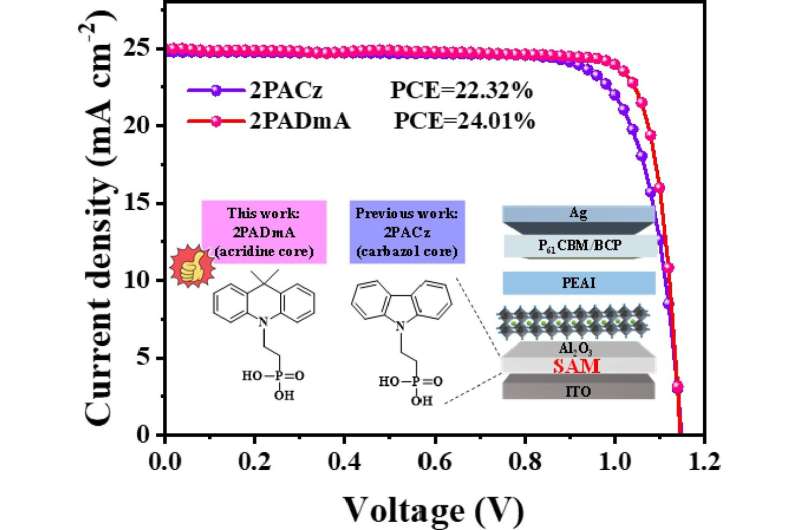
Perovskite solar cells (PSCs) are highly regarded for their exceptional performance and straightforward fabrication. However, traditional hole transport layers (HTLs) like poly (triarylamine) (PTAA), nickel oxide (NiOx), and poly (3,4-ethylenedioxythiophene)-poly (styrenesulfonate) (PEDOT) have inherent limitations that impede efficiency and stability. These materials often suffer from issues such as hydrophobicity, high reactivity, and acidity, which negatively affect the overall performance of PSCs.
Due to these challenges, there is a pressing need to explore and develop novel HTLs that can overcome these limitations and further enhance the capabilities of PSCs.
A team of researchers from Yunnan University and the University of Science and Technology of China has designed and synthesized a new dimethyl acridine-based self-assembled monolayer (SAM), [2-(9,10-dihydro-9,9-dimethylacridine-10-yl)ethyl] phosphonic acid (2PADmA), for use as a hole transport layer in inverted PSCs. The study is published in Energy Materials and Devices.
The research team synthesized a novel dimethyl acridine-based SAM, 2PADmA, and employed it as a hole-transporting layer in inverted PSCs. This SAM modulates perovskite crystallization, enhances carrier transport, passivates defects, and reduces nonradiative recombination. The 2PADmA-based devices achieved a power conversion efficiency (PCE) of 24.01%, significantly higher than the 22.32% PCE of devices using the commonly employed 2PACz SAM.
The increased performance is primarily due to an improved fill factor (FF) of 83.92% compared to 78.42% for the 2PACz-based devices. Additionally, the 2PADmA-based devices showed enhanced stability, retaining about 98% of their initial PCE after 1,080 hours of dark storage and 87% after 400 hours of heating at 85° C, demonstrating superior performance and durability.
Dr. Bing Cai, a researcher from Yunnan University, stated, "The development of the 2PADmA SAM represents a significant advancement in the field of PSCs. This novel SAM not only improves the efficiency and stability of PSCs but also offers a new approach to designing advanced HTLs for future solar cell technologies."
The innovative 2PADmA SAM opens up new possibilities for improving the efficiency and stability of PSCs, making them more viable for commercial applications. This advancement could lead to the development of more efficient and durable solar energy systems, contributing to the global transition to renewable energy sources and supporting efforts to combat climate change.
More information: Liufei Li et al, Dimethyl acridine-based self-assembled monolayer as a hole transport layer for highly efficient inverted perovskite solar cells, Energy Materials and Devices (2024). DOI: 10.26599/EMD.2024.9370038
Provided by Tsinghua University Press
Citation: Unlocking new potential in solar tech: Dimethyl acridine enhances perovskite solar cells (2024, July 25) retrieved 25 July 2024 from https://techxplore.com/news/2024-07-potential-solar-tech-dimethyl-acridine.html
This document is subject to copyright. Apart from any fair dealing for the purpose of private study or research, no part may be reproduced without the written permission. The content is provided for information purposes only.
